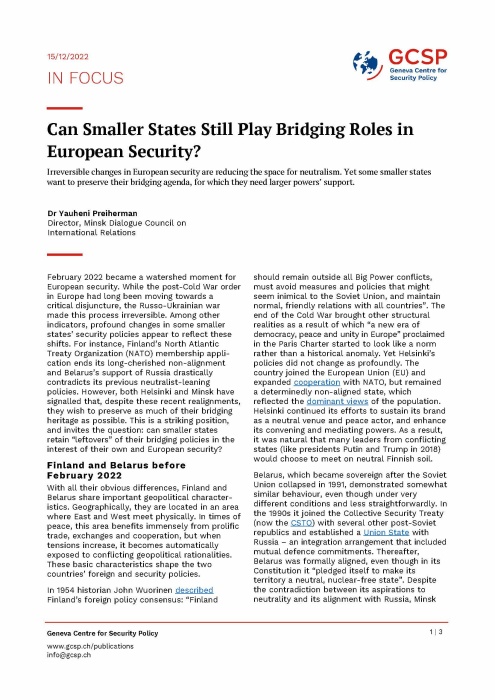Can Smaller States Still Play Bridging Roles in European Security?
Irreversible changes in European security are reducing the space for neutralism. Yet some smaller states want to preserve their bridging agenda, for which they need larger powers’ support.
February 2022 became a watershed moment for European security. While the post-Cold War order in Europe had long been moving towards a critical disjuncture, the Russo-Ukrainian war made this process irreversible. Among other indicators, profound changes in some smaller states’ security policies appear to reflect these shifts. For instance, Finland’s North Atlantic Treaty Organization (NATO) membership application ends its long-cherished non-alignment and Belarus’s support of Russia drastically contradicts its previous neutralist-leaning policies. However, both Helsinki and Minsk have signalled that, despite these recent realignments, they wish to preserve as much of their bridging heritage as possible. This is a striking position, and invites the question: can smaller states retain “leftovers” of their bridging policies in the interest of their own and European security?
Finland and Belarus before February 2022
With all their obvious differences, Finland and Belarus share important geopolitical character-istics. Geographically, they are located in an area where East and West meet physically. In times of peace, this area benefits immensely from prolific trade, exchanges and cooperation, but when tensions increase, it becomes automatically exposed to conflicting geopolitical rationalities. These basic characteristics shape the two countries’ foreign and security policies.
In 1954 historian John Wuorinen described Finland’s foreign policy consensus: “Finland should remain outside all Big Power conflicts, must avoid measures and policies that might seem inimical to the Soviet Union, and maintain normal, friendly relations with all countries”. The end of the Cold War brought other structural realities as a result of which “a new era of democracy, peace and unity in Europe” proclaimed in the Paris Charter started to look like a norm rather than a historical anomaly. Yet Helsinki’s policies did not change as profoundly. The country joined the European Union (EU) and expanded cooperation with NATO, but remained a determinedly non-aligned state, which reflected the dominant views of the population. Helsinki continued its efforts to sustain its brand as a neutral venue and peace actor, and enhance its convening and mediating powers. As a result, it was natural that many leaders from conflicting states (like presidents Putin and Trump in 2018) would choose to meet on neutral Finnish soil.
Belarus, which became sovereign after the Soviet Union collapsed in 1991, demonstrated somewhat similar behaviour, even though under very different conditions and less straightforwardly. In the 1990s it joined the Collective Security Treaty (now the CSTO) with several other post-Soviet republics and established a Union State with Russia – an integration arrangement that included mutual defence commitments. Thereafter, Belarus was formally aligned, even though in its Constitution it “pledged itself to make its territory a neutral, nuclear-free state”. Despite the contradiction between its aspirations to neutrality and its alignment with Russia, Minsk put forward numerous initiatives to de-escalate tensions and enhance cooperation beyond geopolitical dividing lines.
The 2015-2020 period became its heyday. Most notably, Minsk hosted regular peace talks between Russia and Ukraine, including in the Normandy and Organization for Security and Co-operation in Europe Contact Group formats. The status of “good offices” provider and intense cooperation with all sides to the conflict made it possible for Belarus to place the concept of situational neutrality at the heart of its foreign policy. It also promoted various bridging initiatives in areas such as arms control, military risk and transparency, cyber security, and economic cooperation. Symbolically, its signature initiative became known as Helsinki-2 – a proposal for an all-inclusive negotiation process on the future of European security.
The turning point
For Belarus, the situation had already started to change in 2020, when the West imposed sanctions on the country after the presidential election, which the West claimed was fraudulent. More sanctions followed in 2021 due to the landing in Minsk of a Ryanair flight and a migration crisis on the Belarus-EU border. As a result, it seemed obvious that with relations with the West seriously undermined, Minsk would have no room for manoeuvre in terms of its possible attempts to remain outside of conflicts if regional tensions escalated further. And exactly this happened in February 2022. Not only did Belarus become a site from which Russian attacks on Ukraine were launched, but it also deleted the “neutrality aspirations” clause from its new Constitution, while its leadership embarked on harsh anti-West rhetoric.
For Finland, the turning point came in December 2021, when Russia issued its security ultimatums to the United States and NATO. The Finnish authorities interpreted them as depriving Helsinki of the “NATO option”, which, even though it had thus far been avoided, was long seen as a key pillar of the country’s sovereignty and strategic autonomy. Russia’s attack on Ukraine made these concerns insurmountable and brought about a historic shift of Finnish public opinion in favour of NATO membership. The widely shared conviction that “After the war, we will not return to how things used to be with Russia” further strengthened Finland’s resolve to seek a place under NATO’s security umbrella.
How much has changed?
This narrative looks straightforward: two smaller states that pursued neutralist policies in a less confrontational context had opted for full-scale alignment as regional tensions escalated and annihilated geopolitical “shades of grey”. This is what most theoretical schools of thought would expect from these states. However, in public statements and private conversations, officials from both Finland and Belarus seem to be signalling less straightforward intentions.
As a senior Finnish official argued privately, “In a way, everything is changing and nothing is changing, as we have long been so close to NATO and, even with a formal membership, we will continue placing high value on cooperative security”. President Sauli Niinistö appeared to agree: “this is not the right time to totally sever all connections either. There are still practical matters, the management of which is in our own interest. We should also hold channels of discussion open”. Foreign Minister Pekka Haavisto stressed that NATO membership is “not incompatible with other objectives of our foreign policy, such as our human rights based approach, peace mediation or disarmament”.
Similarly, Minsk has combined harsh anti-West rhetoric with regular offers of dialogue. It has even made specific proposals aimed at reducing military risk and increasing transparency. For example, in June 2022 it offered to resume verification activities under existing arms control treaties (unlike Russia, Belarus has not left any such treaties) on a reciprocal basis and invited foreign military representatives, including from NATO countries, to observe the situation on its border with Ukraine. Moreover, Minsk continued to initiate an all-inclusive process for developing a new European security architecture.
How realistic are these aspirations?
Finnish and Belarusian desires to preserve geopolitical bridges are understandable – they reflect these countries’ geography and formative experiences, and their respective perceptions of their vulnerabilities and interests. However, they can succeed in their endeavours only if larger powers allow them to do so. This is a lesson from the Helsinki Process: small bridging states played a crucial role in promoting de-escalation through the Helsinki Accords, but only because key powers made space for diplomacy to succeed. Today’s reality is different from the 1970s, because several actors believe that further escalation of tensions can improve their own standing and undermine their opponents.
Yet all sides seem wary of military risks getting out of control, and the recent incident in which an errant missile from the Ukraine conflict landed in Poland, killing two people, proves that such fears are not groundless. Here the “leftovers” of neutralist policies could also become instrumental for improving European security. Finland could ensure continuous communication and transparency along its 1,300 km border with Russia and maximum “practicality” in terms of Russia-NATO interactions there. Belarus could help to reduce military risk in Eastern Europe through the remaining arms control mechanisms and the advanced bilateral confidence- and security-building measures it has with the Baltic states, Poland and Ukraine.
For the longer-term interests of European security, it also appears crucial that Helsinki and Minsk retain as many elements of their bridging agenda as possible in the worsening escalatory dynamic that characterises the region. NATO and Russia should support this endeavour, because they might wish to benefit from such bridging opportunities before too long.
Disclaimer: The views, information and opinions expressed in this publication are the author’s/authors’ own and do not necessarily reflect those of the GCSP or the members of its Foundation Council. The GCSP is not responsible for the accuracy of the information.


